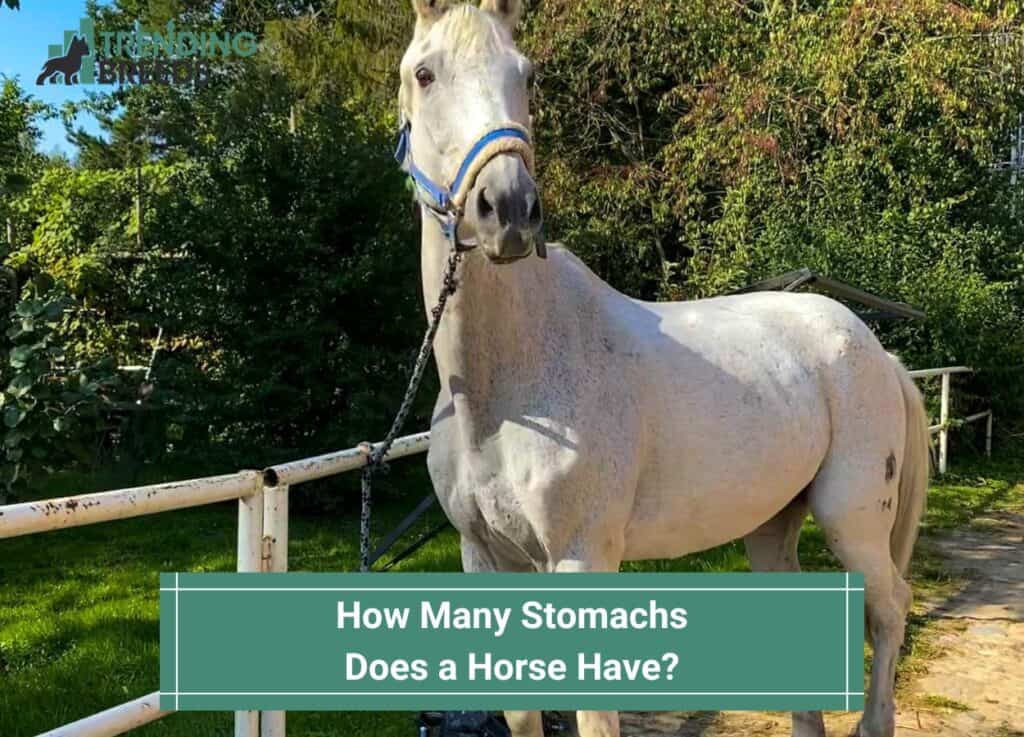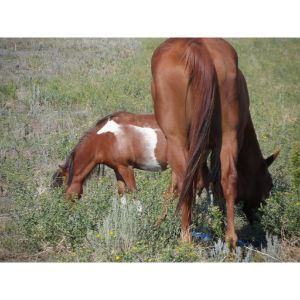
Animal classification can cause significant confusion regarding bodily organs. In addition, the vast diversity created by evolution is evident in every corner of nature, including animals and their biological structures. Therefore, it is crucial to take time to judge and compare animals quickly, as this can result in mixing up facts and leading to inaccurate beliefs. So, how many stomachs does a horse have?
A horse has a single stomach. Unfortunately, ignorance and generalization about the horse’s physiognomy have led many to believe that horses have multiple stomachs, which is invalid.
Thus, it is vital to understand how many stomachs a horse has and why it is significant. Read on to learn more.
Before you scroll further down this guide, check out these other horse-related articles: How Much Water Should My Horse Drink? and Can You Go Horse Riding While Pregnant?.
Table of Contents
Functioning Of a Stomach

As you may already know, all living beings require energy for movement, growth, and reproduction.
Therefore, they must consume food as a source of calories to provide their bodies with fuel for all activities. In other words, they need to eat.
The digestive tract is the system in the body that converts food into energy. It is highly complex and composed of many organs, not all of which are identical.
Therefore, even if animals belong to the same group, such as carnivores or herbivores, they may not have the same organs for digesting food.
Physiology Of a Stomach

The digestive system comprises several organs, including the mouth, esophagus, stomach, and small and large intestines.
However, it is not a hard and fast rule that all living beings must have these organs to digest food.
For instance, plants derive food from soil and sunlight without a stomach. On the other hand, some animals lack a stomach despite having a mouth and consuming food.
As previously mentioned, diversity and combinations are abundant in different organs and ways of digesting food.
The stomach also contains a distal sphincter structure that facilitates food movement into the rest of the gastrointestinal tract.
With the help of gastric acids and pepsinogen, gastric secretion enables the stomach to crush and digest food effectively.
Digestive Tract Of a Horse

The unique physiology of the horse’s digestive system sets them apart from other herbivores, despite their shared grass-based diet.
While they also need to break down cellulose like cows and goats, they don’t require multiple stomachs. However, there are differences in cellulose digestion levels:
Ruminants can digest about 50 to 90% of cellulose in their rumens, while horses’ stomachs have different anatomy and can only digest around 40%.
In addition to its distinctiveness from other herbivores, the horse’s stomach is also specific compared to other domestic animals.
Surprisingly, horses have the smallest stomach relative to their size among average animals.
For instance, a medium-sized horse weighing 800 to 1,200 pounds (360 to 540 kg) can only hold up to 5 gallons (19 l) of liquid in its stomach.
However, the animal can perform and feel its best if its stomach only takes up to 2 gallons (7.6 l).
The Stomach Of a Horse

Let’s begin by examining the different parts of a horse’s stomach:
- First, the esophagus is located at the entrance, followed by the fundus area, stomach body, and gastric gland area. Finally, the pyloric gland area is the stomach’s final part connected to the small intestine.
- When food enters the stomach, it gets in hydrochloric acid and the enzyme pepsin, which begins the digestion of proteins. Solid food particles go through a breakdown during this process.
- As the pH level increases to 5.4, fermentation stops, and the degradation of fats and proteins begins in the fundus area, thanks to pepsin and stomach acids.
- In the pyloric region, which is the final destination of the stomach, the pH level drops to 2.6, eliminating fermentable lactose bacteria. This area is where protein digestion is most efficient.
Digesting food in a horse’s stomach is unique because it can digest cellulose and derive nutrients from grass and hay not only in the stomach but also through fermentation in the hindgut and cecum, where particular microorganisms aid in digestion.
As a result, horses can process food more quickly than animals with multiple stomachs, and the outcome is impressive.
If you want your horse to have a long and healthy life without any digestive problems, it is crucial to consider its delicate stomach.
Provide your horse with a nutritious diet and plenty of fresh, clean water, keeping it hydrated regularly and ensuring it has enough water to drink at least twice daily.
Advantages Of Having a Single Stomach

Here are the advantages horses get with having only one stomach:
- More space in the abdomen and lighter bodies due to a small stomach helps horses to be agile and athletic.
- Fast food processing is due to their stomach structure, allowing them to eat large quantities of food quickly.
- The digestive system empties when 2/3 is complete, whether the digesting is over or not, which can protect the horse from starvation.
- Horses maintain their weight better than cows due to fast food processing.
- However, horses need more energy to be active.
Disadvantages Of a Single Stomach

Having only one stomach unfortunately comes with its downsides:
- Horses don’t extract all essential nutrients from food like cows and sheep do, which affects their need to eat every four hours.
- Ensure your horse is adequately fed within that period to avoid severe digestive problems.
- Horses often have sensitive gastrointestinal bacteria, which can cause digestive issues.
Interesting Facts About a Horse’s Digestive System

A horse’s esophagus is a one-way street
Due to the one-way structure of a horse’s esophagus, they cannot vomit, making a choking incident potentially life-threatening.
Therefore, it is essential to have a knowledgeable staff member available to assist a choking horse, as seeking immediate veterinary attention is crucial in such an emergency.
Having been informed of a choking incident at the barn, I strongly advise against anyone having to witness such an experience, as it is distressing for all involved, particularly for horse enthusiasts.
The equine anatomy does not include a gallbladder

Horses lack a gallbladder due to the design of their digestive system, which doesn’t allow for its accommodation.
According to Ohio State University, horses can digest and absorb significant amounts of fat from their diet despite the absence of a gallbladder.
The liver continuously secretes bile to aid fat digestion, enabling horses to digest and absorb fats efficiently.
Horse gut microbes adapt to their diet
Abrupt changes in a horse’s diet can cause colic as the gut microbes cannot ferment the new food. Therefore, it’s crucial to introduce fresh food gradually to prevent digestive problems and illness.
Empty horse stomach acid can erode the lining

A horse’s empty stomach can contribute to gastric ulcers, highlighting the importance of feeding them small, frequent meals throughout the day.
According to Jennifer MacNicol, a Ph.D. candidate at the University of Guelph, an empty stomach can result in stomach acid splashing up and causing severe harm to the horse’s belly.
Hence, it is advisable to provide horses with constant access to hay to prevent the development of an acidic stomach and gastric ulcers, as recommended by equine experts.
Horses chew on one side of their mouth at a time
Horses grind their food using a slanted outside-to-inside motion of their teeth, limiting them to chew on one side of their mouth at a time.
In addition, the upper and lower cheek teeth break down food before it passes through the esophagus. Understanding the horse’s digestive system makes it worth examining the distinctions between ruminant and non-ruminant animals.
FAQs About a Horse’s Stomach

How many stomachs does a horse have?
Like many monogastric animals, such as humans, dogs, and cats, horses have only one stomach. However, their digestive system is quite different from other monogastric animals.
The horse’s stomach is small relative to their body size and cannot hold food. Additionally, the horse’s digestive system can process a high-fiber diet rich in cellulose found in hay and grasses.
To compensate for their tiny stomachs, horses have a unique digestive system that allows them to digest food quickly and efficiently.
Unlike ruminants such as cows, who rely on a multi-chambered stomach to ferment and digest fiber, horses use a fermentation process in their large intestines, particularly the cecum, a specialized part of the digestive tract.
The cecum contains beneficial bacteria that break down the fiber and extract nutrients from the food, allowing the horse to derive maximum nutrition from its diet.
While horses only have one stomach, their digestive system is adapted to their diet, allowing them to extract nutrients from fibrous plant material efficiently.
How many stomach chambers does a horse have?
A horse has only one stomach chamber and a monogastric digestive system. That contrasts ruminants, such as cows and sheep, with four-chambered stomachs.
The horse’s stomach is relatively small compared to its body size, and it has a capacity of approximately 8 to 15 quarts (7.5 to 14 liters).
Despite having a single stomach, horses can still extract nutrients from rigid fibrous plant material like hay and grass, thanks to specialized microorganisms in their hindgut that assist fermentation and digestion.
So How Many Stomachs Does a Horse Have?

Animal classification can lead to confusion about their bodily organs, and it is essential to understand the vast diversity created by evolution.
Although animals may belong to the same group, they may not have the same organs for digesting food.
The horse’s digestive system is unique; unlike other herbivores, they only have one stomach.
Horses’ bellies are tiny compared to other domestic animals and can hold up to 5 gallons of liquid, and the animal performs best when its stomach takes up to 2 gallons.
A horse’s belly has different parts that aid in the digestion of food, and it can digest cellulose and derive nutrients from grass and hay.
Horses with a single stomach have more space in the abdomen, making them agile and athletic, process food quickly, and maintain weight better.
However, they must eat every four hours to extract all the essential nutrients from food, which can have sensitive gastrointestinal bacteria, causing digestive issues.
If you find this guide, “How Many Stomachs Does a Horse Have,” informative and helpful, you can check out these other horse-related articles from our team:
You can learn more about horse stomachs by watching “3D Horse Digestion Guide” down below:




